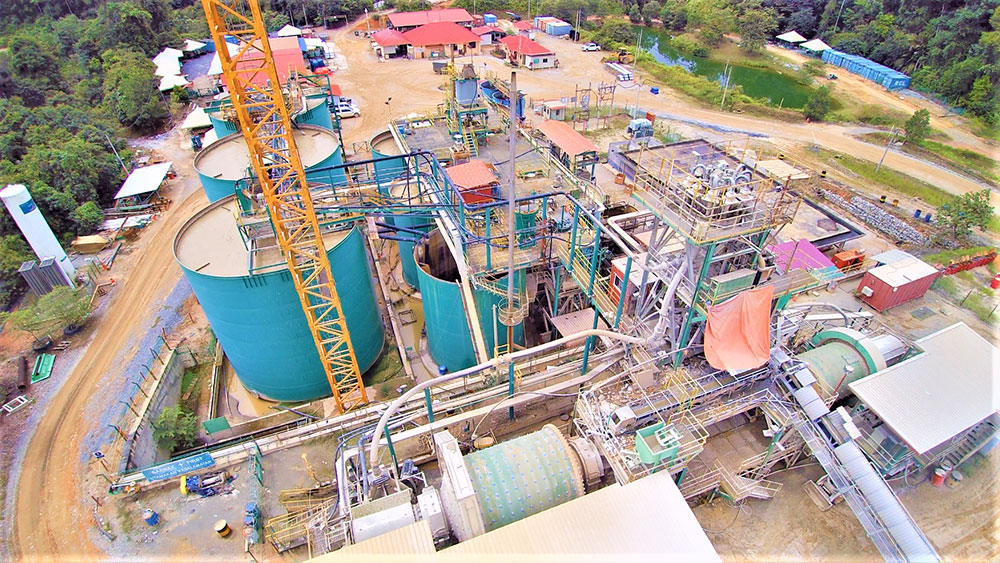Monument Mining reports on progress made with the basic gold processing plant design and the Front End Engineering Design (FEED) for its Selinsing Gold Sulphide Project (SGSP) in Malaysia. Additional testwork programs from independent consultants have pushed out the completion date which is now aimed for mid-August, 2018.
The basic gold processing plant design and FEED form a major part of the feasibility study. It is aimed to convert the existing oxide gold treatment processing plant to a sulphide treatment gold processing plant. As a result, it would allow additional flotation process and BIOX® process to be added to the existing plant with certain alterations to the existing process. To date both design packages have been delivered for Monument’s review, subject to further optimisation should it be required upon additional flotation test work.
The design of the new processing facilities featuring: flotation, BIOX® oxidation, counter current decantation, neutralisation and conventional CIL processing has now been completed by Orway Mineral Consultants and delivered to Monument for review. CIL tailings will undergo conventional cyanide detoxification prior to the Activated Sludge Tailings Effluent Remediation (ASTER™) process. A water recovery thickener will recover the bulk of process water from flotation tailings, neutralisation and ASTER™ discharge. The thickener underflow will be pumped to the existing tailings storage facility.
The BIOX® process is a patented technology for pre-treatment of sulphide-based refractory ores and concentrates ahead of a conventional cyanide leach for gold recovery. Outotec, the owner of the patent has produced an ASTER™ process design package for the biological destruction of residual cyanide and thiocyanate. Operation of the ASTER™ process, as successfully practised at the Runruno BIOX® plant in the Philippines, will provide clean water for milling and flotation and prevent the poisoning of the BIOX® microbes by cyanide compounds.
Contromation Energy Services (CES) has submitted the engineering design of the new processing facilities. The 3D model of the new processing plant has been incorporated into the available space around the process plant while minimising the loss of existing infrastructure. Best use has been made of the local topography with the BIOX® cooling towers located at an elevated position. CES has also provided: major equipment data sheets and specifications; material take-offs for earthworks, civils, structural steel, platework and piping; also the specifications for medium voltage switchgear and low voltage motor control centres, cabling and instrumentation requirements.
SRK Consulting has provided a scoping level design confirming the feasibility to expand the existing TSF. Detailed design will be carried out following further geotechnical investigations and testing of suitable materials from borrow pits and open pit cutbacks.
Perth based geotechnical specialists, Peter O’Bryan and Associates has completed the slope stability studies for both the Selinsing and Buffalo Reef pits, providing recommendations for new slope angles that will provide a safe working environment for the development of these pits.
Following the announcement of bioleaching test results in February 2018, additional bioleaching variability testwork has been conducted by SGS Johannesburg under the supervision of Outotec to determine the metallurgical response of other ore sources to be processed in the first two years of production. The testwork results have shown excellent bioleaching kinetics with 98-99% sulphide sulphur oxidation achieved within 18 days. Cyanide leaching of the BIOX® residues achieved gold dissolution of 94-99% in the standard 24-hour tests. It has confirmed the process being selected is most suitable for Selinsing and Buffalo Reef ore. No more testwork is required.
Iron to arsenic solution grades indicated that the formation of a stable ferric arsenate compound would result and toxicity characteristic leaching procedure (TCLP) testwork confirmed compliance with the USA Environmental Protection Agency requirements. The latest testwork included the testing of Selinsing Pit 5 hanging wall limestone for its acid neutralisation capacity and potential use in the BIOX® reactors and the neutralisation tanks. The limestone was found to have excellent neutralisation characteristics and could be used for pH control in the BIOX® reactor tanks and for neutralisation of the effluent solution and BIOX® residue. Quotations have been sought for suitable crushing and milling equipment both locally and overseas to produce milled limestone slurry.
Additional flotation testwork has been commissioned at the Bureau Veritas laboratory in Perth on further samples of drill core from Buffalo Reef. The aim of the testwork is to provide independent verification of the flotation conditions reported by the in house R&D team that achieved better recovery rate of gold to the flotation concentrate while maintaining the design sulphur grade and mass pull. The Bureau Veritas testwork will be supervised by Orway.
The equipment specifications and data sheets produced by CES have been used by Monument to solicit quotations from appropriate equipment vendors. The quotations received have been combined with the material take-offs and schedules of rates to produce initial capital cost estimates. Quotations have been received for specialist BIOX® and ASTER™ nutrients, flotation chemicals and flocculants towards compiling the operating cost estimate. Both Capex and Opex are under review and will be used for economic assessment in the Feasibility Study. Geological modelling and mine plan review and update are in progress to complete the internal Feasibility Study that will deliver the Sulphide Project Execution Plan, which is also in progress to complete. The delay is primarily caused by external laboratory work, targeting completion in mid-August, 2018.











